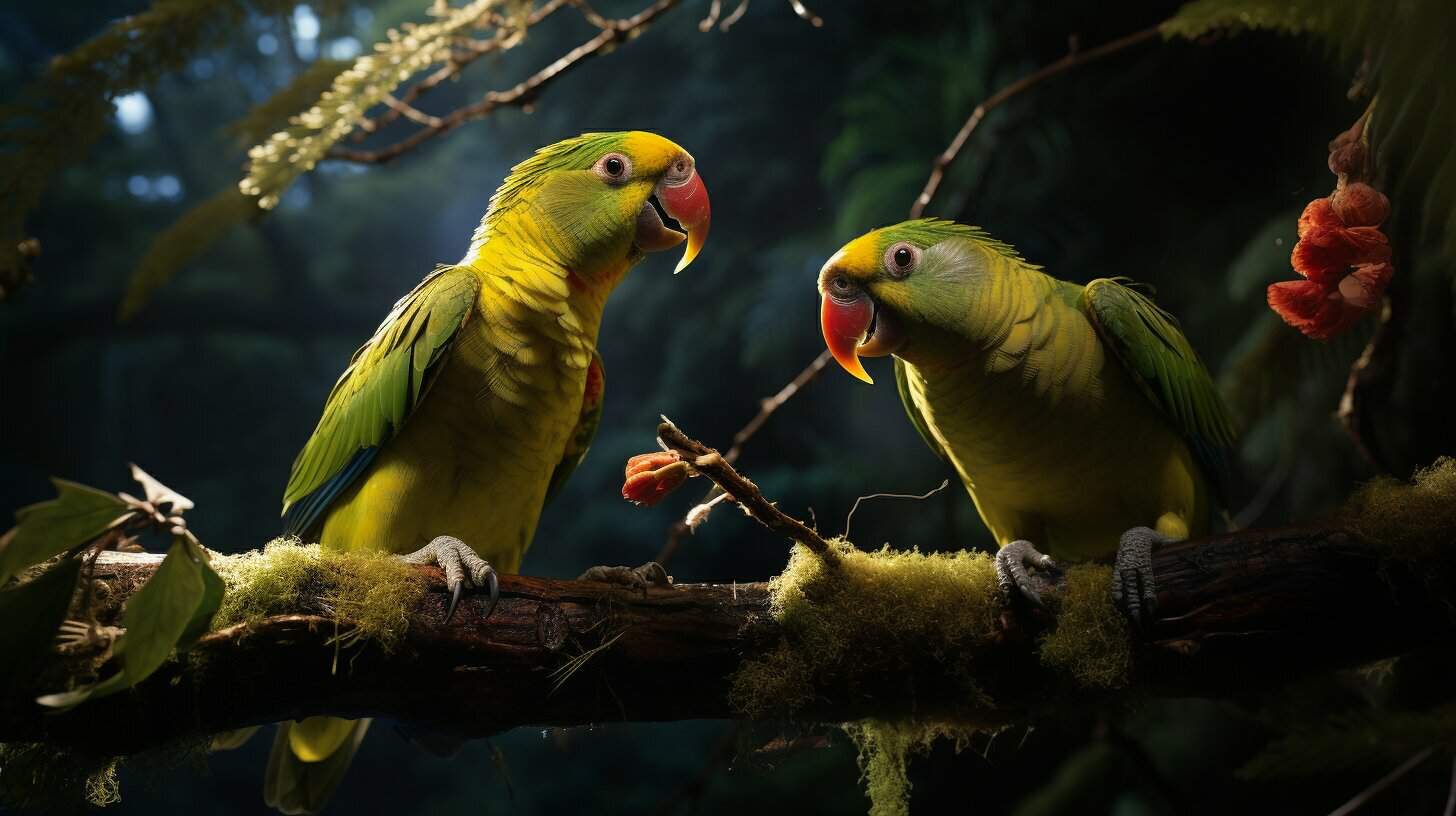If you’re a bird breeder, you may wonder if colony-breeding Kakarikis is viable. Colony breeding keeps multiple pairs of birds together in one large aviary, allowing them to form social bonds and breed naturally. In this article, we will explore the concept of colony breeding kakarikis and provide expert tips and techniques for successful breeding.
Kakarikis are known for their sociable nature and are often kept in pairs or small groups. However, colony breeding can offer several advantages over traditional breeding methods. Colony breeding can promote healthy behaviours and potentially increase breeding success rates by allowing birds to socialise and form natural bonds.
Key Takeaways
- Colony breeding is keeping multiple pairs of kakariki together in one large aviary.
- Colony breeding can promote natural behaviours and potentially increase breeding success rates.
- This article will explore the advantages and disadvantages of colony breeding versus breeding kakarikis in pairs.
Breeding Kakarikis in Colonies vs. Pairs: Which is Better?
Regarding breeding kakarikis, two common methods are colony breeding and pairing individuals. Each method has advantages and disadvantages, depending on the circumstances and preferences of the breeder.
Advantages of Colony Breeding Kakarikis
One of the main benefits of colony breeding kakarikis is that it can promote socialisation and natural behaviours. In a colony, birds can interact with each other, form bonds, and establish a hierarchy. This can improve mental and emotional well-being and potentially increase breeding success rates.
Another advantage of colony breeding is that it can be less labour-intensive than pairing individual birds. Setting up and maintaining a colony may require less effort and time than managing multiple breeding pairs, allowing the breeder to focus on other aspects of care and breeding.
Disadvantages of Colony Breeding Kakarikis
One of the main disadvantages of colony breeding is the potential for aggression and competition between birds. In a colony, dominant birds may prevent others from accessing food, water, and nesting sites, leading to stress and injury. Additionally, it can be difficult to determine which individual birds are responsible for breeding success, making it challenging to breed for desirable traits selectively.
Advantages of Pair Breeding Kakarikis
When breeding kakarikis in pairs, the breeder has more control over which birds mate and can select individuals that exhibit desirable traits. This may be particularly important for breeders interested in developing specific colour mutations or other attributes.
Pair breeding can also provide a more controlled environment for breeding, allowing the breeder to monitor the health and progress of each bird more closely. Additionally, it can be easier to determine which individuals contribute to breeding success and selectively breed for desired traits.
Disadvantages of Pair Breeding Kakarikis
One potential disadvantage of pairing birds is the potential for emotional and social stress. In a paired environment, birds may become too attached to their mate or territorial, leading to aggression and stress. Managing multiple pairs of birds can also be more labour-intensive and time-consuming, particularly if they do not produce viable offspring.
In summary, both colony breeding and pair breeding can be viable options for breeding kakarikis, depending on the breeder’s preferences and circumstances. While colony breeding can promote socialisation and potentially increase breeding success rates, it can also present challenges related to aggression and competition. Pair breeding can provide more control over which birds mate and allow for selective breeding, but it can be more labour-intensive and lead to social and emotional stress.
Tips for Successful Colony Breeding Kakarikis
Colony breeding kakarikis can be a rewarding experience, but it requires careful planning and management. Here are some tips to ensure success:
1. Set up the colony carefully
Ensure the colony setup is spacious, with ample room for all individuals. The colony should have plenty of perches, nest boxes, and feeding stations to minimize competition and aggression.
2. Monitor the social dynamics
It is crucial to monitor the social dynamics within the colony to ensure that individuals are getting along and not showing aggression towards others. Remove any individuals that are causing disruptions or fighting.
3. Provide suitable nesting options
Provide multiple nesting options within the colony to ensure that all individuals have access to a suitable nesting site. It is best to provide various nesting materials, such as shredded paper or pine shavings, to allow individuals to select their preferred material.
4. Ensure optimal conditions for breeding success
Monitor the temperature and humidity levels within the colony to ensure optimal conditions for breeding success. Provide a balanced and nutritious diet to ensure individuals are healthy and in their best breeding condition.
5. Seek expert advice
It is always a good idea to seek advice from experienced breeders and avian veterinarians when colony breeding kakarikis. They can provide valuable insights and tips to ensure the success of your breeding program.
Benefits of Colony Breeding Kakarikis
Colony breeding of kakarikis can offer several advantages over breeding in pairs. These benefits can include:
| Benefits | Explanation |
|---|---|
| Socialization | Colony breeding can promote natural social behaviours and enhance the bird’s overall well-being. By interacting with other birds, they can develop stronger social bonds and display natural behaviours such as play, exploration, and communication. |
| Increased breeding success | Kakarikis are colonial birds and thrive in social environments. Colony breeding can provide a more natural breeding environment and potentially increase breeding success rates. Birds can benefit from observing and learning from other breeding pairs, and multiple females laying eggs can stimulate the males to breed more frequently and effectively. |
| Cost savings | Colony breeding can be more cost-effective than breeding in pairs. With multiple breeding pairs in a larger aviary, there is less need for additional individual cages, food dishes, and other supplies. |
While there are benefits to colony breeding kakarikis, there are also potential concerns and challenges. In larger colonies, monitoring individual birds and ensuring they receive proper care and nutrition can sometimes be difficult. Additionally, there is a risk of disease transmission and potential conflicts between birds.
Ultimately, the decision to colony-breed kakarikis will depend on the breeder’s personal preferences, experience, and resources. It is important to consider the advantages and disadvantages of colony and pair breeding before deciding.
Conclusion
After exploring the concept of colony breeding kakarikis, it’s clear that this breeding method can be a viable option for breeders. Colony breeding can have various benefits, including enhancing socialisation, promoting natural behaviours, and potentially increasing breeding success rates. However, it’s essential to carefully consider the advantages and disadvantages of colony breeding versus breeding in pairs and decide which approach is more suitable for your circumstances.
For successful colony breeding of kakarikis, it’s crucial to set up the colony correctly, manage social dynamics, provide suitable nesting options, and ensure optimal conditions for breeding success. With dedication and careful attention to these factors, colony breeding can be a rewarding and successful breeding method.
Whether you decide to colony breed or not, remember that breeding these exotic birds requires time, effort, and expertise. Always prioritise the welfare of your birds and seek expert advice if needed. With proper care and attention, you can help ensure the success and well-being of your kakarikis.
FAQ
Q: Can you colony breed kakarikis?
A: Yes, colony breeding kakarikis is a viable option for breeders.
Q: What are the advantages of colony breeding kakarikis?
A: Colony breeding can enhance socialisation and promote natural behaviours among the birds.
Q: What are some tips for successful colony breeding of kakarikis?
A: Set up the colony with suitable nesting options and manage social dynamics. Ensure optimal conditions for breeding success.
Q: What are the benefits of colony breeding kakarikis?
A: Colony breeding can increase breeding success rates and provide a more natural bird environment.
Q: Is colony breeding or breeding in pairs better for kakarikis?
A: Both methods have advantages and disadvantages. It depends on the preferences and circumstances of the breeder.
Q: What is the conclusion regarding colony breeding kakarikis?
A: Colony breeding can be a viable and beneficial method for breeding kakarikis, but it requires careful management and consideration of individual circumstances.



Have comments or questions about this article? Then get involved!
Spotted an error or something we have missed? Let us know